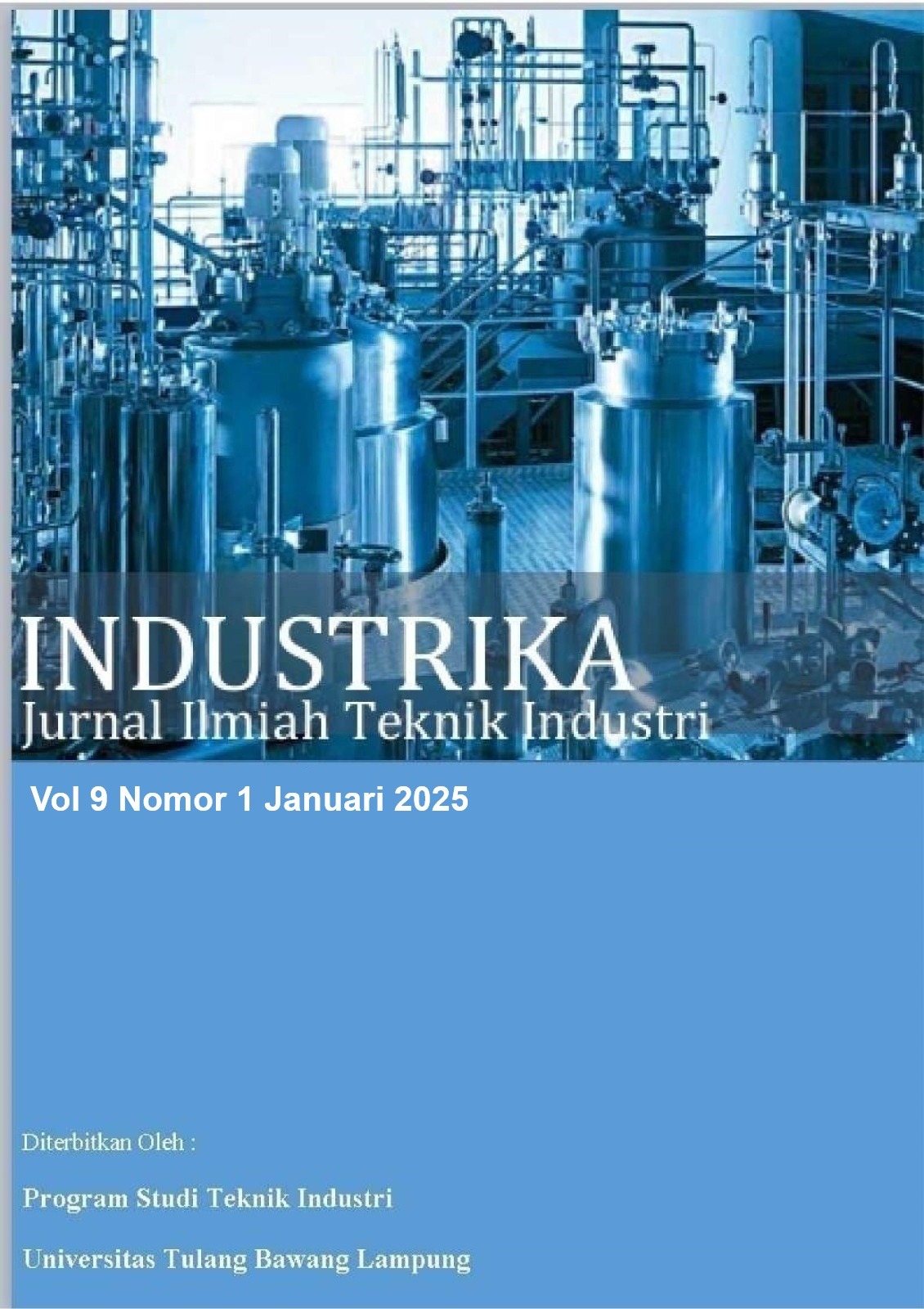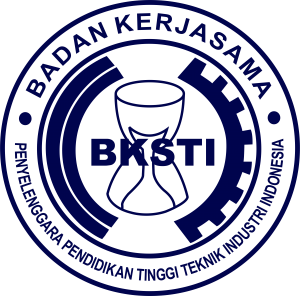Rancang Bangun Alat Pengering Helm Berbasis QFD beserta Analisis Keuangan
DOI:
https://doi.org/10.37090/indstrk.v9i1.1675Abstract
UMKM Helmet and Care is a type of business engaged in the field of helmet-washing services. The helmet drying process is still done manually, resulting in the business process not being able to run optimally. So a solution is needed in the form of a helmet dryer that suits the needs of UMKM. The design of the helmet dryer using the QFD method resulted in the helmet dryer being equipped with a DHT22 sensor and a Thermostat sensor. , the material used is Stainless Steel, the price of the helmet dryer is IDR 5,500,000, the dimensions of the tool are based on worker anthropometry, namely 140 cm = frame height, 70 cm = frame width, 64 cm = frame leg height, 60 cm = frame length, 60 cm = frame length, 83 cm = frame length. The automatic helmet dryer has proven effective in reducing humidity from 80% to 30% in 30 minutes. During the process, the temperature inside the helmet rises from 25°C to 35°C, thus accelerating the drying and showing a positive correlation between decreasing humidity and increasing temperature, Cost analysis calculation using BEP and NPV methods, namely, Investment cost = 3,550,000 can be met for 1.6 months calculated using the BEP method, the results of the NPV calculation in the 36th month produce Pv of proceed = 48,472,051. NPV of 44,922,571. NPV is positive, so the project proposal should be accepted.
Keywords: Automation, BEP, NPV, QFD
Downloads
References
Anita, L. A., & Asmungi, A. (2023). Perancangan Meja-Kursi Belajar Ergonomis Siswa Sekolah Dasar Berbasis Pemetaan Perubahan Data Antropometri. Industrika : Jurnal Ilmiah Teknik Industri, 7(2), 191–198. https://doi.org/10.37090/indstrk.v7i2.982
Eko Ari Wibowo, Galih Mahardika Munandar, Muhammad Nur Wahyu Hidayah, & Widyastuti. (2024). Formula Optimal dalam Penentuan Aspek Penting pada Desain Alat Pemotong Ring AMDK Gelas Plastik Menggunakan Metode Quality Function Deployment (QFD). Industrika : Jurnal Ilmiah Teknik Industri, 8(1), 162–169. https://doi.org/10.37090/indstrk.v8i1.1354
Fajrah, N., & Perdana, Y. `. (2019). Analisis Penentuan Kriteria Kualitas Layanan Pengecatan Mobil. Jurnal Sistem Teknik Industri, 21(2). https://doi.org/10.32734/jsti.v21i2.1222
Ginting, R., Ishak, A., Fauzi Malik, A., & Satrio, M. R. (2020). Product Development with Quality Function Deployment (QFD) : A Literature Review. IOP Conference Series: Materials Science and Engineering, 1003(1), 012022. https://doi.org/10.1088/1757-899X/1003/1/012022
Hafidhin, M. I., Saputra, A., Rahmanto, Y., & Samsugi, S. (2020). Alat Penjemuran Ikan Asin Berbasis Mikrokontroler Arduino UNO. Jurnal Teknik Dan Sistem Komputer, 1(2), 59–66. https://doi.org/10.33365/jtikom.v1i2.210
Ma’arif, M. I., Adhim, F. I., & Istiqomah, F. (2021). Implementasi Metode PID untuk Mengontrol Posisi Motor Servo pada Sistem Sortir Berat Adonan. Jurnal Teknik ITS, 10(2). https://doi.org/10.12962/j23373539.v10i2.71125
Maram, G., Susanto, A. M., & Suwarso, S. (2024). Perhitungan Break Event Point (BEP) pada Usaha Mikro Kecil Menengah (UMKM) “Yuli Bakery” Jember. ACCOUNT (Journal of Accounting and Finance), 2(1), 101–106. https://doi.org/10.31537/account.v2i1.1689
Nurwidah, A., Asni, A., & Haq, A. (2021). Evaluasi Kadar Air Gabah. JASATHP: Jurnal Sains Dan Teknologi Hasil Pertanian, 1(2), 41–45. https://doi.org/10.55678/jasathp.v1i2.548
Putra, M. F., Usman, R., & Rusmiland, R. (2017). Analisis Kelayakan Investasi Pembelian Mesin Filter Press untuk Pengurangan Limbah Sludge. STRING (Satuan Tulisan Riset Dan Inovasi Teknologi), 2(2), 142. https://doi.org/10.30998/string.v2i2.2100
Sabilah, A. I., & Daonil, D. (2023). Analisis Promosi Penjualan dan Kualitas Pelayanan di CV SAU dengan Metode Quality Function Deployment (QFD). Blend Sains Jurnal Teknik, 2(1), 84–93. https://doi.org/10.56211/blendsains.v2i1.292
Sundari, S., Wahyu Pratama, A., Hidayat, G., & Suharto, S. (2023). Penerapan Quality Function Deployment (QFD) Dalam Mendesain Ulang Alat Cabut Singkong Otomatis. Industrika : Jurnal Ilmiah Teknik Industri, 7(3), 285–291. https://doi.org/10.37090/indstrk.v7i3.1128
Susanti, S., Gunawan, W., & Koswara, I. (2023). Pemanfaatan Media Sosial dalam Mengembangkan Pemasaran Batik Sukapura. Jurnal Pengabdian Pada Masyarakat, 8(1), 95–104. https://doi.org/10.30653/jppm.v8i1.215
Suseno, & Theodossy Tigang Huvat, T. (2019). Perancangan Alat Panggangan Otomatis Menggunakan Metode QFD (Quality Function Deployment). Jurnal Teknologi, 12(2), 123–129.
Tomasoa, R. C., & Arief, Z. (2022). Analisis Kelayakan Investasi Mesin Braiding Di Pada Pt.Hapete Di Surabaya. Prosiding Senakama, 1(September), 109–119.
Valentin, R. D., Diwangkara, B., Jupriyadi, J., Riskiono, S. D., & Gusbriana, E. (2020). Alat Uji Kadar Air Pada Buah Kakao Kering Berbasis Mikrokontroler Arduino. Jurnal Teknik Dan Sistem Komputer, 1(1), 28–33. https://doi.org/10.33365/jtikom.v1i1.87
Virnanda, V., Sonia, N., Murnawan, H., & Harijanto, S. D. (2023). Analisis Kelayakan Investasi Alat Bioreaktor Anaerob Sebagai Reaktor Proses Fermentasi Nutrisi Organik. Industrika : Jurnal Ilmiah Teknik Industri, 7(3), 216–224. https://doi.org/10.37090/indstrk.v7i3.989
Downloads
Published
Issue
Section
License

This work is licensed under a Creative Commons Attribution-ShareAlike 4.0 International License.









